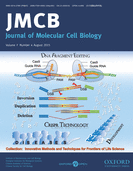
2015年8月13日讯 /生物谷BIOON/ –近日,来自上海交通大学的研究人员在国际学术期刊JMCB发表了一项最新研究进展,他们发现应用CRISPR/Cas9技术可以轻松实现对DNA片段的倒位和重复,对于基因组中存在的大量DNA调控元件和大量基因簇的功能研究具有一定意义。
研究人员指出,人类基因组中包含了几百万个DNA调控元件和大量的基因簇,但其中大部分都没有进行过实验检测,还有大量基因组”未解之谜”等待人类去破解。
DNA编辑技术CRISPR/CAS9近年来风生水起,该系统是目前发现存在于大多数细菌与所有的古菌中的一种后天免疫系统。由于CRISPR/Cas技术作为一种最新涌现的基因组编辑工具,能够完成RNA导向的DNA识别及编辑,为构建更高效的基因定点修饰技术提供了全新的平台,受到众多科学家的追捧。
在该项研究中,研究人员利用CRISPR系统和两条sgRNA在人类和小鼠的基因组中轻松实现对靶向DNA片段的倒位和重复。研究人员利用该技术可以在培养的人类细胞和小鼠中对几十bp到几千kb大小的DNA片段实现高效精确倒位。同时通过两条同源染色体上Cas9诱导的双链断裂,利用CRISPR技术还可以实现DNA片段的重复和删除。除此之外,研究人员还利用CRISPR技术获得了携带精确倒位,重复和删除不同尺寸DNA片段的等位基因的小鼠。
最后,为证明该技术在DNA调控元件功能研究方面的作用,研究人员将CRISPR方法应用到Pcdhα基因簇的调控元件功能研究中,发现了对Pcdhγ基因簇成员调控的新功能。
总的来说,这项研究表明应用CRISPR/Cas9这种简单高效的方法能够大大促进对DNA调控元件及基因簇功能的研究,这对于破解人类基因组中的大量”未解之谜”具有很大助益。(基因宝jiyinbao.com)

Efficient inversions and duplications of mammalian regulatory DNA elements and gene clusters by CRISPR/Cas9
Jinhuan Li, Jia Shou1, Ya Guo, Yuanxiao Tang, Yonghu Wu, Zhilian Jia, Yanan Zhai, Zhifeng Chen, Quan Xu and Qiang Wu
The human genome contains millions of DNA regulatory elements and a large number of gene clusters, most of which have not been tested experimentally. The clustered regularly interspaced short palindromic repeats (CRISPR)/CRISPR-associated nuclease 9 (Cas9) programed with a synthetic single-guide RNA (sgRNA) emerges as a method for genome editing in virtually any organisms. Here we report that targeted DNA fragment inversions and duplications could easily be achieved in human and mouse genomes by CRISPR with two sgRNAs. Specifically, we found that, in cultured human cells and mice, efficient precise inversions of DNA fragments ranging in size from a few tens of bp to hundreds of kb could be generated. In addition, DNA fragment duplications and deletions could also be generated by CRISPR through trans-allelic recombination between the Cas9-induced double-strand breaks (DSBs) on two homologous chromosomes (chromatids). Moreover, junctions of combinatorial inversions and duplications of the protocadherin (Pcdh) gene clusters induced by Cas9 with four sgRNAs could be detected. In mice, we obtained founders with alleles of precise inversions, duplications, and deletions of DNA fragments of variable sizes by CRISPR. Interestingly, we found that very efficient inversions were mediated by microhomology-mediated end joining (MMEJ) through short inverted repeats. We showed for the first time that DNA fragment inversions could be transmitted through germlines in mice. Finally, we applied this CRISPR method to a regulatory element of the Pcdhα cluster and found a new role in the regulation of members of the Pcdhγ cluster. This simple and efficient method should be useful in manipulating mammalian genomes to study millions of regulatory DNA elements as well as vast numbers of gene clusters.
 基因君官网
基因君官网